new posts in all blogs
Viewing: Blog Posts Tagged with: Cybils nominees, Most Recent at Top [Help]
Results 26 - 50 of 67
How to use this Page
You are viewing the most recent posts tagged with the words: Cybils nominees in the JacketFlap blog reader. What is a tag? Think of a tag as a keyword or category label. Tags can both help you find posts on JacketFlap.com as well as provide an easy way for you to "remember" and classify posts for later recall. Try adding a tag yourself by clicking "Add a tag" below a post's header. Scroll down through the list of Recent Posts in the left column and click on a post title that sounds interesting. You can view all posts from a specific blog by clicking the Blog name in the right column, or you can click a 'More Posts from this Blog' link in any individual post.
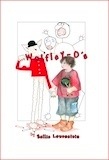 Wolfley-O's
Wolfley-O's
by Sallie Lowenstein
On the last day of the first week of first grade, Davey doesn't want to go back to school. The other kids pick on him, call him names, and push him down on the playground. Then he discovers an unusual box of cereal in the pantry. On the box is a space that reads, "Wolfley-O's! The cereal that ____________________________." After Davey fills in the blank with "Builds Your Confidence," he finds that he does, indeed, have more confidence the next day at school.
Throughout the week, more blanks for different attributes appear on the cereal box, and as Davey fills them in, he finds that things improve at school. The week culminates when a recipe for Wolfley-O cookies appears on the box, and Davey makes the cookies to share with the other kids at school.
Wolfley-O's is a fun and empowering story for kids about the power of imagination to shape our world. Sallie Lowenstein understands well, and does a great job of portraying, the fluid line between imagination and reality for young children. Is the box of Wolfley-O's real or in Davey's imagination? It really won't matter to the kids reading the story.
Lowenstein is good at getting into the mind of a child, and Davey is an appealing character that kids will identify with. The art is lovely, with great attention to detail; for example, Davey's socks are bunched up and coming off in one illustration. The kids at school start out as a child's stick figures at first, then gradually gain detail and transform into fully drawn and shaded characters as Davey gets to know them.
The recipe for Wolfley-O's cookies is included in the story. It sounds delicious enough that I'd like to try it, yet simple enough for a young child to make (with adult supervision).
Wolfley-O's is a Cybils nominee in the Fiction Picture Books category.
FTC required disclosure: Review copy (F&G) provided by the publisher to enable me to write this review.
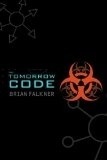 The Tomorrow Code
The Tomorrow Code
by Brian Falkner
When New Zealand teens Tane and Rebecca start receiving coded messages from the future, they realize that the world is in trouble. As they begin to decipher the code, they discover that the messages come from their future selves - and contain a worrisome SOS. Tane and Rebecca, along with Tane's brother Fatboy, frantically work to decode the messages and follow the instructions before it's too late. The three teens may be the only ones who stand between the world and disaster.
The Tomorrow Code is a highly suspenseful, exciting eco-thriller reminiscent of the work of Michael Crichton, but with better writing. It's a terrifying page-turner, with interesting, believable characters. Tane and Fatboy are Maori, and although they are in most ways modern teenagers, they are also in touch with their Maori heritage, a heritage that becomes important later in the story. The glimpses of Maori culture are interesting.
Rebecca is brilliant, the daughter of scientists. She excels at math and science, but it's interesting that she isn't always the one to solve the problems. I love the importance that the author gives to multiple intelligences, as it takes the very different skills of the three of them to solve all the problems.
The Tomorrow Code is a 2009 Cybils Fantasy/Science Fiction - teen nominee.
Edited to add: There's a lot of great information about the science, technology, geography and culture from the book, including a stunning gallery of New Zealand photos that has me dying to go there, on the Tomorrow Code web site.
Disclaimers: I received a review copy from the publisher to evaluate for the Cybils award. The Amazon links above are Amazon Associate links, and I earn a very small percentage of any sales made through the links. Neither of these things influenced my review.
Tracy Grand of Jacketflap has once again created this terrific Cybils nominee widget. It rotates through the Cybils nominees and displays a different one each time the page is loaded. You can get the widget for your own blog here. The best part is that it's completely customizable! You can choose the colors and the categories that you want to display. I set mine to display the Fantasy/Science Fiction nominees, of course, and I also included the Graphic Novel nominees since some of them have SFF themes.
 Tiger Moon
Tiger Moon
by Antonia Michaelis
Translated by Anthea Bell
When Safia becomes the eighth wife of the Rajah Ahmed Mudhi, she knows that she will die. Safia's name means "virtue," but Safia is not a virgin, and when the Rajah finds out that he has been deceived, he will kill her. Luckily, the Rajah is ill right after their wedding, and Safia has a few more days to live. Like Scheherazade, Safia tells stories while she waits to die. But Safia's listener is not her husband, but a young eunuch called Lalit.
A young thief named Farhad Kamal finds a silver amulet in a lotus flower, which marks him as the hero chosen to rescue the god Krishna's daughter from the demon king Ravana, who plans to marry her at the next full moon. Farhad knows that he is no hero, but Krishna makes it clear that if Farhad doesn't succeed, he'll be reborn in his next life as a worm, and the cycle of his lives will be prolonged to infinity before achieving Nirvana. Not wanting to risk such a fate, Farhad sets off to find the magical mount promised to him by Krishna, to take him to the city at the heart of the desert of Rajasthan where Krishna's daughter is being held.
As Safia tells Lalit the story of Farhad, both of them are transformed by the story in unexpected ways. And Farhad himself just might become a hero after all.
I adore Tiger Moon! It's such a beautiful story, richly written with a folk-tale feel, yet it also has a smart, sassy voice and an almost modern sensibility that makes it really fun to read. Here's an example:
Sometimes he visited one of the great temples to pray to the gods, and as chance would have it, he usually came out again with a handful of coins from the plate left out for offerings. He had tried going into the new British church, too, but the donation boxes there were kept well locked, so he decided against converting to Christianity. The Muslims were clever and had driven him straight out of their mosque. So Farhad remained a Hindu out of what might be called his economic convictions, and on the whole he looked after himself successfully.
The writing is lovely, and Anthea Bell has done a wonderful job of translating it. The story resonates with warmth and humor. It's a poignant story of sacrifice and true heroism. And who wouldn't love Nitish, the sacred white tiger with a fear of water?
Tiger Moon does contain some mature content.
Disclaimers: I received a review copy from the publisher to evaluate for the Cybils award. The Amazon links above are Amazon Associate links, and I earn a very small percentage of any sales made through the links. Neither of these things influenced my review.
Sheila Ruth has the list of 2009 Fantasy/SciFi Cybils Nominees up at Wands and Worlds. I noticed some familiar titles and authors. Among them:
The Last Olympian by Rick Riordan.
Ottoline Goes To School by Chris Riddell.
Skeleton Creek by Patrick Carman.
Stonewall Hinkleman and the Battle of Bull Run by Michael Hemphill and Sam Riddleburger.
Authors I've read with nominated titles I haven't read:
Joni Sensel, Jonathan Stroud, Anne Ursu, M. T. Anderson, Angie Sage, Derek Landy, Michael Buckley, P.J. Haarsma, and Holly Black.
And, finally, I noticed that Pamela F. Service is nominated for Camp Alien. It's been years since I've read anything by Service, but she is memorable at Chez Gauthier for Stinker From Space.
For someone who isn't a major fantasy fan, I seem to have read a lot of it.
The following books were nominated for the 2009 Cybils in the Fantasy/Science Fiction category at the Teen level:
 Soulstice (The Devouring #2)
Soulstice (The Devouring #2)
by Simon Holt
Little, Brown
Nominated by: Melanie
Reviewed by: Nettle
 Academy 7
Academy 7
by Anne Osterlund
Speak
Nominated by: Mia Thompson
Reviewed by: Nettle
 Amaranth Enchantment, The
Amaranth Enchantment, The
by Julie Berry
Bloomsbury USA
Nominated by: Stacey (AKA Aubrey)
Reviewed by: Gwenda007
 Another Faust
Another Faust
by Daniel And Dina Nayeri
Candlewick Press
Nominated by: Finn
 ArchEnemy (The Looking Glass Wars)
ArchEnemy (The Looking Glass Wars)
by Frank Beddor
Dial
Nominated by: Shannon Messenger
 As You Wish
As You Wish
by Jackson Pearce
HarperTeen
Nominated by: Abby
Reviewed by: Nettle
 Ash
Ash
by Malinda Lo
Little, Brown
Nominated by: Michelle

The following books were nominated for the 2009 Cybils in the Fantasy/Science Fiction category at the Elementary/Middle level:
 11 Birthdays
11 Birthdays
by Wendy Mass
Scholastic
Nominated by: Maggi Idzikowski
Reviewed by: Charlotte | Eva
 Any Which Wall
Any Which Wall
by Laurel Snyder
Random House Children's Books
Nominated by: Sarah Neal
Reviewed by: Charlotte | Eva
 Brotherhood of the Traveling Underpants (Melvin Beederman, Superhero), The
Brotherhood of the Traveling Underpants (Melvin Beederman, Superhero), The
by Greg Trine
Henry Holt
Nominated by: Sherrie Petersen
 Camp Alien (Alien Agent)
Camp Alien (Alien Agent)
by Pamela F. Service
Carolrhoda Books
Nominated by: Elizabeth Dingmann
Reviewed by: Eva
 Candle Man, Book One: The Society of Unrelenting Vigilance
Candle Man, Book One: The Society of Unrelenting Vigilance
by Glenn Dakin
Egmont USA
Nominated by: Babs
 Century #1: Ring of Fire
Century #1: Ring of Fire
by Pierdomenico Baccalario
Random House Children's Books
Nominated by: Amanda Snow
Reviewed by: Eva

 The Ask and the Answer
The Ask and the Answer
Chaos Walking, Book Two
by Patrick Ness
Warning: This review is slightly spoilerish to the first book, The Knife of Never Letting Go, so if you haven't read that book, I recommend you stop now and read it first. I loved the first book, but qualified my review with a caution about the ending. Having read the second book, I can now give the series an unqualified recommendation. It's an outstanding series, and one with a lot of teen appeal. My only warning is that bad things happen, and this isn't a series for sensitive readers.
My Review of The Knife of Never Letting Go
The Ask and the Answer was an unexpected surprise. I knew it would be good - I think I hardly even breathed while reading The Knife of Never Letting Go - but I didn't expect it to go in the direction that it did. The Knife of Never Letting Go was one long, breathless flight, with Todd and Viola alternately running from and battling the forces from Prentisstown. The cliffhanger ending led you to believe that the second book would be more of the same. And while The Ask and the Answer picks up where The Knife of Never Letting Go left off, Ness turns everything upside down and forces you to question your assumptions and look at everything and everyone in a new light.
I don't want to say too much and ruin the book, but The Ask and the Answer finds Todd and Viola separated, and at times, on opposite sides. They are each, in their own way, doing what they can to stand up for what's right, but right and wrong aren't always clear, and it's hard to know who, or what, to believe.
The Ask and the Answer is a deep, powerful, and sometimes disturbing book, which asks such questions as, do the ends ever justify the means? And if one side is evil, does that make the opposition good? There are echoes of the Holocaust, particularly in the treatment of the Spackle. The Ask and the Answer is as breathlessly unputdownable as The Knife of Never Letting Go, but it's also a book that shakes you up and makes you think. It's a book that I think will have strong appeal to teens.
Guest Review by David
My 14-year-old son David also reviewed this book. Here is his review:
Oh, my gosh. Was it even possible for this book to top it's predecessor? Yup. If anything, this book is even more well written than The Knife of Never Letting Go, and that's saying a lot. The characters are all great, from the villains, to the heros, to those who just aren't sure what they are. And the plot? The plot is the best part. I don't want to give away too much, but it's almost impossible to put down The Ask and The Answer after you start. This book has quickly risen up my list of favorite books, along with The Knife. I've already reread them both twice, and I still can't get enough!
--SLIGHT SPOILERS--
Whereas the first book ended leaving the reader with a feeling of defeat, this book, even though it has no less of a climactic ending, gives you a better feeling. More "Aaaaaaaah!" as opposed to "Noooooo!" if you will. If you enjoyed The Knife of Never Letting Go, there's no way you shouldn't read this book.
The Ask and the Answer is a 2009 Cybils Nominee
Disclosures: we received a review copy of The Ask and the Answer from the publisher at my request. The links above are Amazon.com affiliate links, and if you purchase the books (or anything else) through those links, we'll earn a very small percentage. None of these things influenced the reviews.

Into the Volcano by Don Wood is another one of the elementary/middle grade graphic novelCybils finalists I'm determined to tell you all about.
Volcano is a well-done graphic novel (no narrative and plenty of wordless panels where the images carried the story) that is also a realistic adventure. It has that classic kidlit device of the missing, mysterious parent, but in this case she is not some fantasy figure but (be still my heart) a scientist! (This feminist-leaning woman of a certain age could just weep.) She's also sort of an adventurer out to collect some kind of pearl. She has a falling out with her sister who is also a partner in her pearl gathering scheme. Her two sons, who had been living in what appeared to me to be the United States with what looks to be their wealthy father, are invited out to visit their aunt, who plans to use them to help find scientist mom and the pearls.
In a volcano.
So the kids take part in a dangerous adventure that is resolved by the end of the book. Personally, I'm always satisfied when a story is wrapped up at the end of a book, and this one also involves a change for one of our main characters. Meaning readers get some character development with their adventure.
In the event that you are one of those adults who can't resist pushing a little education with your kids' recreational reading, you can check out Wood's Story Behind Into the Volcano for an account of his research--told graphically.
I forgot to direct your attention to the Easy Reader finalists for the Cybils. Easy readers, like graphic novels, are of particular interest for me. Not that the rest of the finalists aren't interesting.
I seem to be really struggling to get over Christmas this year. I suspect that if I went back and looked at my end of the year posts, I'd find that I have trouble getting over it every year. Though who has time for that? I have reason to hope to be back to my so-called normal rituals by Tuesday. Then, of course, I leave for a week's vacation next Saturday.
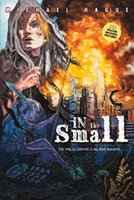
I'm going to say right up front that as a general rule, I'm not terribly fond of apocalyptic novels. They tend to be very similar, I think. Everything's dreadful. People are suffering. Humankind usually brings the whole thing down on itself through messing with nature, religion, war, science, global markets. Somehow it's my fault.
In the graphic novelIn the Small by Michael Hague we're brought down by a mysterious blue light. After the light is gone, all of humanity (or so it appears) has shrunk. How will people survive when almost every creature on the planet is larger than they are and evidently carnivorous? Personally, I was impressed by how many family pets had been waiting their chance to turn on their human masters.
The survival aspect of the story is interesting and moves along quickly. However, the main character, Mouse (that's got to have some kind of meaningful significance) Willow, has premonitions or visions that make it possible for him to know just what needs to be done. What's more, as he's leading a group of co-workers from his father's office out to the 'burbs, he runs into one of those stereotypical street people who also has visions. Street guy's visions mesh very nicely with Mouse's.
The whole vision thing seemed out of place to me. It seemed like a quick and dirty way of giving a teenage boy a leadership position. His sister back home is quite a mighty sprite, and she doesn't need any visions.
Though some of the human figures in the panels seem a little roughly drawn, I don't think that's unusual in graphic novels. This is a color novel with glossy pages.
In the Small has been nominated for a Cybil in the Elementary/Middle Grade Graphic Novel category, though the publisher describes the book as young adult. Since the main character and his sister, the other big figure in the story, are teenagers and there are no major child characters in the book, young adult seems a more appropriate classification to me.
Parenthetical.net reviewed this book back in October.
Michael Hague was interviewed on In the Small at Newsarama.
Colleen at Chasing Ray interviewed Martin Millar, whose Lonely Werewolf Girl has been nominated for a Cybil in the Young Adult Fantasy and Science Fiction Category. The interview is part of the 2008 Winter Blog Blast Tour.

A Frankenstein story is one in which scientists play God, messing with nature to create life. The end result is rarely good. (Think Jurassic Park. Or Alex Award winner Never Let Me Go.)
Like Never Let Me Go, The Adoration of Jenna Fox by Mary E. Pearson is a very high quality Frankenstein story. Its characterization equals its plotting, and it's very elegantly written. The outcome for The Adoration of Jenna Fox is far different than the outcome in Never Let Me Go, though. It's not your run-of-the-mill Frankenstein story ending.
Jenna Fox has just come out of a lengthy coma at the beginning of her story, which is set in a future United States that has suffered your usual futuristic disasters involving disease, earthquake, and economic breakdown. She seems in remarkably good shape, though, and the only medical person she sees is her father, the head of some kind of biotech firm. She has survived a horrendous accident that she can't recall. Things come back to her slowly. Things come to the reader slowly.
Slowly, in this case, is not a bad thing.
This book deals with some big issues, such as what it means to be human (I'm sorry, I kept thinking of Data on STTNG--not that there's anything wrong with that), parental love, rationing health care, and identity. But it doesn't do it in a pretentious, heavy-handed way. The Adoration of Jenna Fox has a scifi/thriller aspect that keeps it from feeling like too much of a problem book and a teen angst problem aspect that keeps it from falling into scifi/thriller cliches.
Personally, I could have done without the epilogue, but I never like epilogues.
I think some might argue that The Adoration of Jenna Fox ends the way it does because it's YA and YA must be hopeful. But I think that doesn't give it credit for asking an interesting question about the traditonal Frankenstein scenario--Is it really wrong to do this?
The Adoration of Jenna Fox is a Cybils nominee in the Young Adult Fantasy and Science Fiction category.
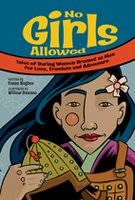
I remember enjoying a book when I was young about a girl who disguised herself as a man so she could fight in the Civil War. So the premise behind No Girls Allowed: Tales of Daring Women Dressed as Men for Love, Freedom and Adventure by Susan Hughes and Willow Dawson certainly appeals to me.
I have to say, though, that I didn't find this graphic presentation of short pieces on seven different women particularly successful. A lot of the panels required those little narrative boxes to explain what was going on, and I still sometimes found myself confused. The snakes that appear in the story of Alfhild, a Viking princess, threw me, for example. A prince arriving to see her kills two snakes that appear out of nowhere. The princess then says, "Sir, you have killed my vipers." He apologizes and says, "It was the only way for me to win your hand in marriage!" The next page includes a confusing panel that suggests the king had set up the kill-the-vipers-marry-my-daughter scenario. The scene appears to show Alfhild discussing the marriage proposal with her family. In fact, we're told in a box that that is what she's doing. But at the bottom of the panel, another box of text appears in which we're told that her father delayed consulting her. The graphics and text actually appear to contradict one another.
Some of the women's motivation for taking on the life they do isn't very clear, either. That's particularly the case for Alfhild and Esther Brandeau.
The accounts of nineteenth century women work better, probably because there looks to be more documentary evidence and more for the writer and illustrator to work with.
Another confusing aspect of the book: Some of the stories are based on historical fact, while others are based on legend. I think that makes the overall project less focused than it could have been.
So I didn't feel the book worked all that well, either graphically or as nonfiction. The subject matter may be of high interest to young readers, but I'm not sure if twenty-first century children feel the narrowness of women's lot in life the way children of earlier generations did.
For a different reaction and an interview with the author see Big A, little a's New Voices Blog Tour: No Girls Allowed.
No Girls Allowed is a Cybils nominee in the graphic novels category. (Though it definitely isn't a novel.)
Another graphic novel post at Oz and Ends. This one is about 2007 Cybils nominee Robot Dreams.
Colleen Mondor has a Graphic Tales column up at Bookslut that includes a number of Cybils nominees:
Skim and Emiko Superstar by Mariko Tamaki,working with Jillian Tamaki and Steve Rolston, respectively;
Coraline by Neil Gaiman, adapted by P. Craig Russell;
The Good Neighbors: Kim by Holly Black with Ted Naifeh.
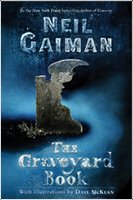
Though I've enjoyed some of Neil Gaiman's work, I'm not what you might call a Gaiman Groupie. I'm not enthralled by everything he does.
His new novel, The Graveyard Book, is really good, though.
The book begins with a multiple murder, for those of us who enjoy getting right into the action. The one survivor, a toddler, ah, well, toddles off and ends up in an old cemetary where he is taken in by ghosts, adopted by a couple who've been members of the spirit class for a few hundred years, and given the run of the place. He's raised by the cemetary dwellers in the graveyard, the only save place for him because his family's murderer is still looking for him.
Personally, I think that's enough of a description to hook anyone. But I will add that the book is structured in what are pretty much short stories (Gaiman says so, too, in an interview with Jessa Crispin, which is really more him talking to her than her interviewing him), each one an adventure with our protagonist at a different age. And there's a lot of dark humor about the dead.
I have a couple of nitpicks. One, how did Bod know to go to a pawn shop or even how to find one when he left the graveyard to try to raise some money? Two, I found the art work odd. There's quite a bit of it, when you consider this is a novel, which is just fine. But the details in the early illustrations gave me the impression that the book might be set in the early twentieth century. It's definitely contemporary. Plus Bod is described as dressed in a winding sheet in the text early on, but he's shown in clothes in the illustrations.
But, yes, that is nitpicking.
The Graveyard Book is a Cybils nominee in the Fantasy and Science Fiction (Middle Grade) category. I think middle grade is a better description of it than YA, which is how it's categorized at my local library.
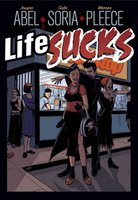
Personally, I believe there's an under-the-radar sort of genre involving books about early-twenty-something characters who are coming to terms with the fact that life, well, sucks. That pretty much describes, in a nutshell, the graphic novel Life Sucks by Jessica Abel, Gabe Soria, and Warren Pleece.
The basic set-up for this book is just brilliant. Two years before the start of our story, our hero, Dave Miller, applied for a night job at a convenience store so he could attend community college during the day. The store owner, Radu, (who prefers to be called Lord Arisztidescu) is an immigrant (from some eastern European country, I'd guess)who turns Dave into a vampire. Now Dave must be Radu's...er, Lord Arisztidescu's...low-wage slave--through eternity! As if that isn't bad enough, Dave can't tolerate the idea of blood so he can't go around preying on humans. This means he'll never become a strapping, healthy vampire, just a miserable, little weak one with a job working permanent nights. Really permanent.
Yes! Life does, indeed, suck!
While not necessarily roll-on-the-floor funny, Life Sucks definitely is drole and clever, particularly if, like me, you enjoy dark, subtle humor. There's lots of humorous takes on traditional vampire lore. And, I guess, traditional convenience store lore.
I can't say I loved the art, but it is dark and moody to fit the subject matter, and it carries the narrative very well. I read a rather lame graphic novel a couple of weeks ago that had to use a lot of what I think you might call narrative boxes because the graphics weren't telling the story by themselves. Nothing like that here. The art carries everything but the dialogue.
This book would be a big draw for your older, edgier YAs who are already beginning to suspect that life sucks. While I was reading it, I was wondering who I knew who might like it for Christmas.
Life Sucks is one of this year's graphic novel Cybils nominees.
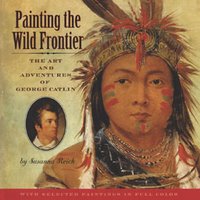
My impression of the nineteenth century is that it was a time when people had a big interest in things outside themselves—natural history, art, and philosophy, for instance. At the same time, you saw some remarkable bigotry. Susanna Reich's biography of George Catlin, Painting the Wild Frontier: The Art and Adventures of George Catlin, confirms my feelings about that incredibly interesting century.
You may not be familiar with George Catlin's name, but you've probably seen his work, particularly The Cutting Scene. Catlin was a nineteenth century artist who made painting American Indians (the term Reich uses) his life's work, both in terms of art and business. Early in Painting the Wild Frontier, Reich says of him, "Would people pay to look at paintings of Indians, he wondered, the way they paid to look at the Greek statues and the paintings of Revolutionary War heroes in Peale's museums?"
He gambled that they would.
The first part of Painting the Wild Frontier deals with Catlin the artist and adventurer. He believed the Plains Indians were still relatively untouched by contact with Europeans and seemed sincerely interested in documenting them and their lives with his art. Except for a few unattractive incidents that indicate that he was, indeed, a nineteenth century man, (the buffalo he shot but didn't kill and allowed to struggle in pain so he could sketch it from better angles, for instance, and his insistence on visiting a quarry considered a sacred site, even going so far as to take a sample of the rock away with him) Catlin comes off well during his productive years.
Making a living from art is almost always a problem, and in Catlin's case, he appears to have been a better painter than businessman. Though he ran successful exhibits in the United States and London, he wasn't able to hold on to money. An argument could be made that he also exploited Indians who appeared in his exhibitions. In his later years, he could have been a model for the artist tragically fallen on hard times.
When literary agent Nathan Bransford described his fantasy MFA Program he said, "Good nonfiction has an underlying arc and a satisfying conclusion." Reich definitely finds an underlying arch in George Catlin's life story, and while its conclusion may not be satisfying in terms of happily ever after, it's satisfying in terms of being a conclusion that fits in with what came before. While I kept hoping he would redeem himself as I read the latter part of the book, I can't say I was surprised when he didn't.
The art of our past is important because before cameras it was the only way to preserve how people and things looked. Archaeologists sometimes use art to help them date items--if a cup is similar to one in a painting from the late eighteenth century, then it, too, may very well come from that period. Thus Catlin's art is important no matter what we may think of him. Painting the Wild Frontier includes enough of it to almost be considered an art book. Some of the illustrations are in black and white, some are in color, and all are beautiful. Captions not only discuss the work, but identify the individuals in the paintings, making them real people who lived on after they were painted, who had families and perhaps descendants walking among us today.
Pay particular attention to the timeline at the back of the book, in which Reich shows us what was going on in the U.S. at various points in Catlin's life. While reading Painting the Wild Frontier, you'll definitely get a feeling for the nineteenth century world, but it's here in the timeline that you really get hit with some of the inconsistencies of the period. In 1838, for instance, while Catlin's Indian Gallery exhibit is a big hit with the citizens of four eastern cities, 4,000 Cherokee Indians die on the Trail of Tears while being forcibly relocated by the federal government.
This is a piece of work that could really get young readers interested not only in the subject covered but in reading history, period.
Painting the Wild Frontier has been nominated for a Cybil.
You can read a lot more about Painting the Wild Frontier next week, when Susanna Reich will be doing a blog tour. She'll be getting started on Monday at Becky's Book Reviews and stopping here on Thursday when we'll be talking history.
Parenthetical.net reviews Coraline. I wasn't looking forward to reading the graphic version of Coraline because, like the reviewer at Parenthetical, I wasn't crazy about the original book. This review makes the graphic novel sound more enticing.
Parenthetical.net also reviewed Three Shadows.
Pink Me reviews Cybils nominee The Merchant of Venice. Gareth Hinds also did a graphic novel version of Beowulf, by the way.

Incarceron
by Catherine Fisher
Incarceron is a 2007 Cybils finalist.
Incarceron is a prison, a penal colony of sorts. All "criminals, undesirables, political extremists, degenerates, lunatics" were placed in Incarceron, along with 70 wise men called Sapienti to guide them, and then the prison was sealed. No one can enter or leave Incarceron and only one person—the Warden of Incarceron—even knows where it is located.
Centuries later, most of the inmates don't believe that "outside" even exists. But Finn does. Finn has no memories of a time before he awoke in a cell in Incarceron a few years back. Most people believe he was born of Incarceron - a child of the prison created from the recycled bits and pieces of human waste. But Finn believes that he came from Outside, and is determined to find a way back. Life in Incarceron is brutal, violent, and harsh, and Finn survives through a combination of wits and recklessness, and with the help of his oathbrother, Keiro. When Finn gains possession of an ancient artifact, a crystal key, he believes it is proof that he came from Outside. Finn and Keiro, along with an elderly Sapient and a rescued slave, embark on a quest to find the way out of Incarceron.
Claudia is the daughter of the Warden of Incarceron, a position of wealth and prestige. But Claudia is trapped as surely as the inmates of Incarceron; she lives in a society bound by strict social rules, and her destiny was set for her from the time she was a young child, when she was betrothed to the Crown Prince of the Realm. The Crown Prince, Caspar, is spoiled, self-absorbed, and unpleasant. Claudia can handle Caspar—her father has trained her for this her entire life—but the thought of a lifetime of nothing but court politics is depressing for the spirited, curious young woman. Claudia believes that the key to her future lies in Incarceron, and along with her tutor, a Sapienti named Jared, seeks a way into the prison.
As Claudia seeks a way in and Finn seeks a way out, the two come into communication. Each finds that they must come to terms with a reality that is far different than either expects. As they battle for their lives, dark secrets are revealed and loyalties called into question. And the greatest enemy of all may be Incarceron itself.
Incarceron is a riveting book that keeps you turning pages. There are plenty of plot twists, mysteries, excitement, and secrets to hold your attention from the beginning to the very end. Even things that seem obvious may not be as they seem; there's enough ambiguity to keep you guessing.
The characters are fascinating and have depth and dimension, even many of the minor characters. Many of them seem to be holding back secrets, and motivations and loyalties aren't always clear. Finn and Claudia are remarkably well-drawn and complex characters. Living in such a brutal environment, Finn has had to develop a certain ruthlessness and recklessness to survive, and yet somehow he has managed to keep a sense of compassion and humanity as well. Claudia is also ruthless in her own way, and well-suited to the political machinations of her world, yet increasingly impatient with them. She fears her father, and yet retains an independence of self in spite of her years of training. As the story progresses, she becomes increasingly willing to take risks and step outside what is expected of her.
Although much is resolved and much is revealed, there are some things left open at the end of the book, and the reader is left with a sense that there are still secrets left to be revealed. Luckily, there's a sequel in the works, to be called Sapphique.
Unfortunately, Incarceron is not published in the U.S. yet. It is available from some of the Marketplace vendors on Amazon.com, or from Amazon UK.

Dragon's Keep
by Janet Lee Carey
When King Arthur's younger sister Evaine was exiled to Wilde Island, Merlin made a prophecy to her:
The signs all point to the twenty-first queen of Wilde Island.... Three things the stars say of this queen. She shall redeem the name Pendragon. End war with the wave of her hand. And restore the glory of Wilde Island.
...And yet I see darkly in the stars...a beast"
Many years later, Evaine's descendent Rosalind grows up knowing that she is to be the twenty-first queen of Wilde Island and destined to fulfill the prophecy. But there's one problem: Rosalind was born with a birth defect. The ring finger on her left hand is a dragon's claw instead of a finger, a sure mark of the devil. Rosalind has had to spend her entire life gloved, for fear that someone will see the mark.
Rosalind's mother, Queen Gweneth, is determined that she will find a way to heal her of her mark. She believes that once healed, Rosalind will marry the English Prince Henry, currently in exile in France, and that the two of them will become king and queen of England. To this end, Queen Gweneth subjects Rosalind to the ministrations of healer after healer. None of the healers are allowed to know what the problem is, of course, so they have to work without knowing what they are trying to cure. Some of the cures are unpleasant, and none of them works.
A dragon's mark is especially bad, because Wilde Island is beset by a dragon, who attacks and kills the inhabitants. Dragons are not looked on with favor on Wilde Island. When the dragon abducts Rosalind, she learns a lot more about dragons than she ever wanted to know, and her destiny turns out to be very different than she expected.
Dragon's Keep is a beautiful book, but a dark one. Rosalind's life is such a horror, and that the pain of it is caused by the mother who thinks she is doing the best for her daughter is unspeakable. When Rosalind is abducted by the dragon, her life is still a horror, but in a very different way. It raises the question of just who is the beast in Merlin's prophecy: the dragon or the mother? Queen Gweneth reminds me of some parents who push their children too much in areas such as sports or acting, thinking that they are helping their child and not realizing that they're carrying it too far. (As a stage parent myself, I can see how easy it is to get carried away and think that you are doing what's best for your child).
Dragon's Keep also shows how different sides in a war can perceive the same things very differently.
Dragon Slippers, which I reviewed yesterday, deals with the same theme. It was interesting reading these two books so close together. They are, in many ways, very different books: where
Dragon Slippers is humorous and lighthearted, although with some darker moments,
Dragon's Keep is dark and intense.
The dragons in the two books are very different as well; the dragons in
Dragon Slippers are so very human whereas the dragons in
Dragon's Keep are clearly a different species with an alien (to us) way of thinking. And yet both books deal with the same theme of reconciling the "us vs. them" mentality in a war. In
Dragon Slippers, the author takes the approach of making the dragons so likable that the reader can easily bridge the gap between "us" and "them." The dragons in
Dragon's Keep, however, seem harsh to us, and yet as time goes on, we begin, as does Rosalind, to understand how they think, and we find ourselves drawn to them. And so the gap is bridged, and bridged in a way that has a stronger psychological impact.
I hope that my description hasn't led you to believe that these weighty themes drag down the story, because they don't. I doubt I would have noticed all the above quite so strongly if I hadn't read both books practically back-to-back during my
Cybils reading.
Dragon's Keep is a strong story, exciting, and enjoyable to read. The plot twists and revelations hold your interest and pull the story along. I highly recommend it for anyone with an interest in dragons, or who just likes interesting, thought-provoking fantasies.

Dragon Slippers
by Jessica Day George
Dragon Slippers is a 2007 Cybils nominee.
Creel and her brother Hagen live with their aunt and uncle, who took them in when their parents died. But the family is poor, and Creel, with no prospects for a good marriage, is a liability. So Creel's aunt sets her mind on a plan: Creel will offer herself to the dragon, and when the dragon takes her prisoner, a brave knight will rescue her and marry her, taking the entire family to live in his castle. Creel knows it's a stupid plan, but she has no choice but to go along with it.
Right from the start, things don't go according to plan. The dragon doesn't want to take her prisoner. He really doesn't want to battle a knight. And he doesn't hoard gold; he hoards shoes. Creel makes a deal with him: she'll leave, taking the need to battle the knight with her, in exchange for a pair of shoes. As Creel heads off to seek her fortune in the city, she has no idea just how much trouble those shoes are going to cause...
Dragon Slippers is a must-read book for dragon fans. It's a delightful book with a fairy-tale feel, but with more depth and better developed characters than your typical fairy tale. The story is told in the first person, and Creel's voice is a fascinating blend of naiveté and worldliness. She has a certain appealing innocence about her, and yet she displays quite a bit of grit and determination.
But the best thing about this book is the dragons. Author Jessica Day George has imbued her dragons with distinctive personalities. And each dragon hoards something different: one collects shoes, another one tapestries and others...well, you'll just have to read it and see. I don't want to give too much away. From the noble Shardas to the anxiety-ridden Feniul, you'll love them all. The book is at its best when the dragons are in the picture.
There's more to this book than dragons, though. There's a budding romance with a prince and even a ball, but Creel is no passive Cinderella. She's determined to make her own way in the world, and the ball is one for people who want to start their own business to help them find patrons to invest money to get them started. There's also a war, and heroes, and a message about how leaders sometimes distort the truth for their own ends.
For all Creel's good points, though, at times she seems a bit dim. You want to slap her for the things that she doesn't see. And the book drags a little in places. Overall, though, it's quite an enjoyable story that will appeal to dragon lovers and those who love modern fairy-tale type stories.

Northlander
Tales of the Borderlands: Book One
by Meg Burden
Northlander is a 2007 Cybils finalist.
Ellin's father Rowan is a healer, the best in the Southlands. When the Northland king becomes gravely ill, his advisors send to the Southlands for Rowan to come and help. But Northland laws and Northland prejudice prevent Rowan from touching the king, so he's forced to do what he can by proxy: brewing herbs and giving advice. When a crisis happens and Rowan is away, Ellin ignores the laws and heals the king herself, an act that will have far-reaching consequences. For although she saved the king, she did break the laws, an act that can't be forgiven no matter what the result.
In healing the king, Ellin awakened her own latent healing powers. She also discovered that she has other powers as well, powers which she instinctively knows that she must keep secret, even from her own father. But Ellin discovers that she's not the only one who has these powers, and even in the cold Northlands Ellin finds friends. But prejudice, ignorance, and fear exist everywhere, and friends may not be enough to save Ellin.
There's a lot to like about Northlander. Rich world-building and interesting characters are only the start. It's a moving, layered fantasy with many unexpected plot twists. Ellin is a wonderful character; the present tense gives her first-person narration an immediacy that allows us to see her develop as she grows in understanding. But more than that, author Meg Burden pulls off a difficult feat: she gives the five sons of the king, including the twins, distinctive personalities. It would be easy to fall back on cliches in creating a group of siblings like that - the brainy one, the leader, etc - but Burden gave each character depth and ongoing development.
Northlander is a book that continues to surprise the reader. At first it seems a standard, cliched us vs. them: the evil Northlanders are prejudiced against the good Southlanders. But it turns out to be so much more than that. I can't say too much without giving away some of the surprises, but this is a book painted in a rich palette of many shades of gray, not just black and white. It's a book that shows how prejudice and hatred can exist anywhere there is ignorance and fear, and goodness can be found in the most unexpected of places.
View Next 16 Posts
 Wolfley-O's
Wolfley-O's































sounds intriguing...just put it on my library request list!
My work is done.
I loved this book. I thought the way Pearson handled the limited POV with a hero who just CAN'T know anything was fantastic. Also, Jenna is, by default--at the beginning--a very nonactive person, but becomes SUCH an active hero.
One of the things I particularly liked was the way that Jenna, as she recalled more and more, wasn't always a one hundred percent lovely person. It was a good combination of a real YA character with a science fiction scenario.
And that she hadn't been a one hundred percent strong person "before." I loved having the grandmother character to help reveal these kinds of things.
Another nice point--parental love was portrayed in a complex way. It would have been very easy to do an "oppressive parental love" thing here and portray the parents as heavies. But the author didn't go that way.
Yes, nobody made a "right" or "wrong" choice. Perfect way to show there may not have been one.